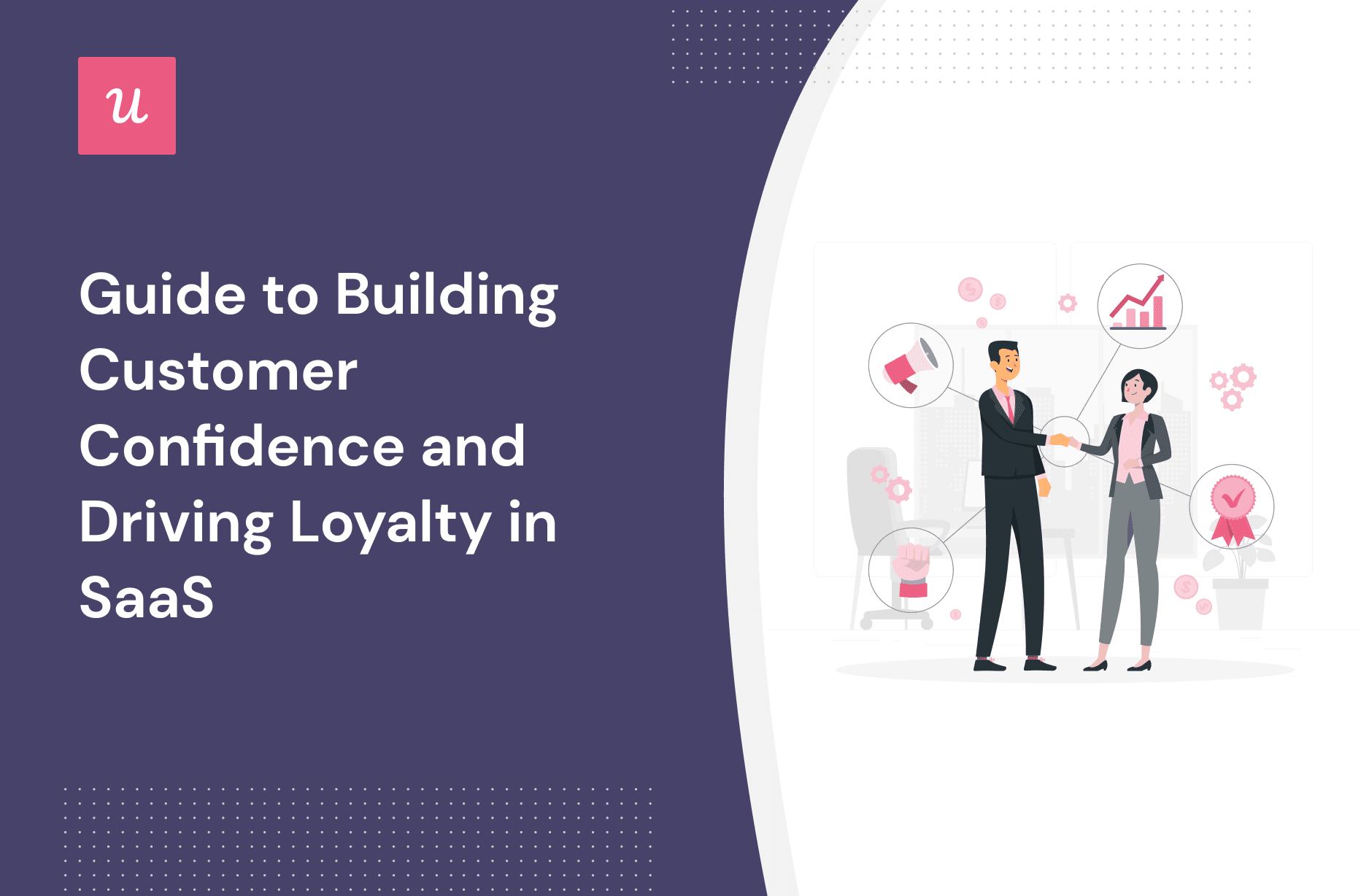
Customer confidence isn’t just a way to close sales more easily. It’s also the foundation to:
- Build customer loyalty
- Attract good-fit customers
- Boost product growth
So even after the deal is closed, you should still care about customer confidence—which involves following the tactics we’ll show you in this article.
Let’s start with the definition:
Try Userpilot Now
See Why 1,000+ Teams Choose Userpilot

What is customer confidence?
Customer confidence is the level of trust a B2B prospect has over your brand before making a decision. Be it a complex purchase or an account expansion, your customer should feel “confident” that they have sufficient information and trust you enough to move forward through their journey.
Customer confidence vs. customer loyalty
Although customer confidence and loyalty are closely related, they’re different.
Think of it like this: customer loyalty is based on past experiences, while confidence focuses on a bright future.
Loyalty is based on customer relationships you’ve built over many transactions, and it’s based on the positive experience that your customer had with you.
In contrast, customer confidence is based on trust and ensuring that your customer gets everything they need to move forward. Plus, it eventually leads to customer loyalty when done well.
Why is customer confidence important?
Without customer confidence, users would be very averse to mistakes and flaws from your business—making them sensible to churn.
But more than that, here’s why you need to lift your customer’s confidence:
Customer confidence results in repeat purchases and retention
When a customer decides to trust you to make a purchase and ends up having a positive experience, you’ll reinforce their trust in you—resulting in repeat purchases and more retention.
Customer confidence increases your revenue
As your customer keeps making purchases and renewing their plan, their lifetime value (LTV) increases—resulting in higher revenue for your business.
Trusting customers will praise you publicly and drive referrals
Once you’ve achieved customer satisfaction and users are happy with your product, they’ll be more likely to recommend your brand to their peers and increase word-of-mouth.
How can you measure customer confidence?
You can’t just ask people if they trust you, so customer confidence is not really a metric you can track.
However, there’re a few ways to tell if your customers are feeling confident:
Understand how customers feel about you with Net Promoter Score surveys
NPS surveys measure loyalty by asking, “How likely are you to recommend us to a friend from a scale of 0 to 10?”
Those who answer 9 or 10 are your advocates and loyal customers, which is an accurate indicator of how many customers trust your brand and are confident in the value you provide.
Measure the upsell rate
The upsell rate is the number of customers who’ve bought more than one product for every customer who only bought one.
This metric is important because it indicates how many of your customers have enough confidence to upgrade their plan and get through their next stage in the journey.
How do you build customer confidence?
Now, how do you foster such a level of trust? Here are some best practices to follow:
1. Build trust by personalizing product experiences
A personalized product experience is required to build a good level of trust and confidence.
In fact, the Zendesk Customer Experience Trends Report shows that 76 percent of consumers expect personalization, which means you can no longer get away with just calling users by their names.
A truly personalized product experience delivers value according to your customer’s use case, job to be done (JTBD), and the journey stage—building rapport and making users feel confident.
You must collect data and segment users based on their needs, in-app behaviors, NPS responses, and product usage.
And with segmentation, you can:
- Recommend new relevant features to each user persona.
- Offer in-app guidance when the user is stuck.
- Prompt an upgrade when the user has reached their plan limits.
- Send email sequences to support users.
- Trigger in-app experiences according to their in-app behavior.

2. Provide guidance and help users achieve their goals in-app
To maintain healthy confidence levels, you must constantly reassure users and remind them they’re in the right place.
For this, guide new users with UI patterns like tooltips, modals, and checklists to introduce features and encourage them to stick around.
Make sure to follow the last tactic and use segmentation to personalize specific flows to different types of users.

3. Be transparent and honest with customers during chaotic times
Customers will only trust you if you’re transparent. So it’s always a good idea to communicate what you’re working on and announce product changes, such as price increases, so customers have enough time to adjust.
For instance, if you are sunsetting a feature, give them time to transfer their data and take all the necessary precautions before it gets deleted.
Users are resistant to change, so communicate well in advance and use multiple channels such as social media, in-app messaging, and websites to ease the process.
Use mobile in-app messaging to offer guidance or support users through features they might not be familiar with.
For example, here is a website banner for a pricing update on StoryChief. Which is a gentle way to announce minor pricing updates without disrupting the user experience:

4. Ask for customer feedback and act on it
Customers trust brands that demonstrate they care about them.
For this reason, collecting feedback is useless if you don’t close the feedback loop.
You see, when you receive feedback, you should act on it and communicate with your customers to make them feel heard—or else it feels like wasted time.
So, for your customer feedback strategy, you should:
- Collect qualitative feedback like in-app surveys, feature feedback surveys, and more.
- Analyze the responses, reach out to users to point out an already existing feature, and make improvements based on it.
- Keep customers on track, and announce when a user-requested feature is now implemented. Mobile surveys are a quick way to measure customer satisfaction, gather real-time feedback, and boost engagement.

5. Deliver top-notch customer service
As said earlier, you must ensure that customers have everything they need to move forward.
And one big part of it is to offer first-class support whenever the user faces an obstacle.
First, train your customer service agents or CSMs and enforce a company-wide customer-centric culture. Make sure to show empathy whenever a customer makes contact.
But you can’t be available 24/7. Which is why you need to provide self-service support.
This way, users don’t have to leave your app, google your website, scroll down to find the support button, and browse through messy documentation to find answers.
The best knowledge bases combine all the self-help resources, such as articles, video tutorials, and webinars, to ensure every person will find support in a way that works for them.

6. Increase customer confidence with loyalty programs
Loyalty programs and rewards help reinforce the emotional connections required to build trust and confidence.
Offer limited deals, discounts, access to premium features, etc. for your loyal customers.
For instance, Evernote’s point-based program rewards you with points for inviting friends.
Your referrals get premium access when they sign up, and you get points that you can collect and exchange for a premium plan.

7. Offer free educational resources
Educating users is a key building block of customer confidence.
As a Conductor study shows, educational content makes customers 131% more likely to buy (and move forward through their journey).
If you don’t want to overwhelm customers with too many resources, you can use short and on-point video tutorials.

8. Acknowledge your mistakes and offer solutions
Own your mistakes if you want to protect your customer’s trust.
When there’s a bug, malfunctioning design, or any unexpected result, take responsibility and let your customers know they’re in good hands.
Asana’s error messages are a great example of how you can humanize your UI:
- It exposes their brand personality and brings light-hearted humor to ease the situation.
- It has a genuine apology and shows a clear, actionable message so you easily know what to do next.
- Has a direct CTA to fix the problem.

9. Support a social cause and unite your customers around a mission
Serve a mission that’s bigger than you, so you can demonstrate that you’re not just doing business for the money (which, in turn, makes it easier to trust your brand).
For example, Whereby’s program offers to plant a tree for every meeting hosted on their platform:

10. Refrain from using dark patterns in your UI/UX design
Every internet user has experienced dark patterns at different levels.
Common examples include misdirection when you click links, hidden costs, difficulty canceling subscriptions, etc.—tricky UIs that make you do things you don’t intend to do.
And in SaaS, it’s commonly used during billing.
Auto-renewing SaaS subscriptions without notifying customers and using a number of tricks that make it difficult for them to cancel may bring you profit for a few months but surely isn’t worth the drawbacks that come along with it.
The apparent issue with this practice is that it will instantly kill your customers’ trust once they face it—and you don’t want that. And besides customers will be quick to write negative reviews or social media posts exposing you that will utterly destroy all the confidence you’ve built.
11. Share positive reviews and testimonials
85% of consumers put their faith in online reviews, and according to HubSpot, 60% believed that customer reviews were either very trustworthy or trustworthy.
Hence, showing testimonials and reviews on your website, blog, and social accounts is very valuable if you want to build customer confidence.
But how do you get customer reviews?
- Asking for a review after the user has finished their onboarding.
- Using in-app surveys or patterns to encourage customers to leave a review.
- Use mobile surveys to gather customer feedback
For example, we prompt this modal to users with high NPS to gather G2 reviews:

Conclusion
Building customer confidence requires a lot of collaboration, and there’s only so much you can do from your position.
Thankfully, in a customer success environment, you can follow and automate these tactics to make your users happier and grow trust.
So, why not try a Userpilot demo and see how you can build customer trust without coding?







